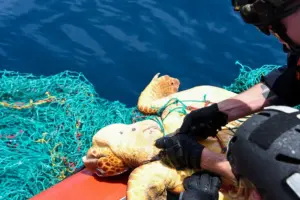Original article: Lovell, T.A. (2023) Understanding the drivers, scale and impact of abandoned, lost and otherwise discarded fishing gear in small-scale fisheries: an Eastern Caribbean perspective. Frontiers in Marine Science, 10, 2296-7745, doi10.3389/fmars.2023.1139259.
Marine debris is a complicated global problem, but it is an important one that must be addressed to increase the sustainability of global fisheries. One of the most harmful types of marine debris is derelict fishing gear (lost or discarded), which threatens marine life and seafloor habitats like coral reefs since traps and nets can continue to catch fish and other marine life long after they have been discarded. Derelict fishing gear can also present navigational hazards for boats, snorkelers, and divers, rendering areas with high rates of pollution unsafe.
Though researchers and much of the general public can understand the hazards of fishing gear pollution, the full scale and scope of this problem is hard to quantify. Researchers who study marine debris acknowledge that data on the scale and spread of marine debris is limited, especially for remote regions, like the eastern Caribbean, that rely on small-scale fisheries. It is important to understand how much fishing debris is out there, and the rate at which it enters the ocean, so that government agencies and researchers can come up with practical solutions.
A Hot Spot for Marine Debris

In the Caribbean islands, small local-scale fisheries are more common than large commercial fisheries. Most of the fishers in this region depend on homemade traps and buoys, which are highly vulnerable to loss frombad weather, theft, and other disruptions. Combining this with a large marine-based tourism industry, the Caribbean islands generate more waste per capita than the global average and a majority of this waste ends up in the ocean.
In order to get a better grasp on the scale of fishing gear pollution in the eastern Caribbean, researchers at the World Maritime University and resource managers in Dominica, Antigua and Barbuda interviewed fishers and divers around these three islands in the eastern Caribbean. A total of 50 fishers and 14 divers were interviewed across Antiqua/Barbuda and Dominica in order to understand how often local fishers lost fishing gear, how the gear was lost, and how often divers encountered discarded gear while on their dives.
34% of Fishing Traps Are Lost Per Year
For both Antigua/Barbuda and Dominica, fishers most often lost their gear due to bad weather and snagging on obstructions, which are difficult causes to control. Another common cause was over-crowded fishing grounds and high boat traffic. With all causes considered, Caribbean fishers lose an average of 2,273 traps per year, or 34% of total traps deployed in the region.
In Antigua/Barbuda, vandalism and theft were also major drivers of fishing gear loss, which perpetuated economic loss in the area. To counteract theft, local fishers on these islands have the practice of setting “blind traps”, in which two traps are tied together and deployed without a surface marker. Instead, these fishers mark the location of their traps with GPS. Unmarked traps however present dangers for boats, divers, and wildlife, and they also are more likely to be lost by drifting or are unretrievable when the fishers return for them.
In Dominica, severe weather, strong currents, and deep water were the biggest cause of gear loss for local fishers. Theft and vandalism were less prevalent in Dominican waters, so fishers often mark their traps with buoys in this region. However, many of the fishers interviewed use homemade buoys such as plastic jugs or Clorox bottles. These homemade markers are harder to see by vessels and/or can be mistaken for floating debris, which leads to higher rates of boat collisions with the gear and can lead to trap loss when the jugs fill with water.

Fishers in both regions were also asked questions about how they intentionally dispose of their traps when their gear reaches the end of its life. 40% of trap fishers said they intentionally discard their traps at sea once the traps reach the end of their life. Most fishers in this area use wood framed traps with wire mesh and oftentimes, the fishers indicated that they separate the wire mesh from the wood frame before disposing of them. Most fishers stated that they repair metal-framed traps, ropes, buoys, and other plastic components of their gear.
Over 50% of Divers Frequently Encounter Discarded Gear
The researchers asked divers how often they encountered fishing debris and what types they found. Most of the divers indicated that fish traps, plastic netting and rope were the most commonly encountered forms of fishing gear pollution in both Dominica and Antiqua/Barbuda. More than half of all divers reported that they encounter fishing gear fragments frequently and 25% said they sometimes or rarely observe the debris.
Interestingly, the polypropylene nets most often seen by divers are not commonly used by local fishers in the area. Instead, these polluting nets probably drifted into the coastal waters of Dominica and Antigua/Barbuda from larger offshore commercial fishing operations. Regardless of the source, these survey results overwhelmingly showed that lost or discarded fishing gear is a prevalent source of human pollution in the Eastern Caribbean.
The results of this study show that environmental factors (bad weather, strong currents, etc), socioeconomic factors (theft, vandalism, homemade buoys), and common customs (intentionally discarding expired gear) are the biggest sources of fishing gear pollution in the eastern Caribbean. This study provides critical baseline data which can be used to compare with similar data from other regions. The authors note that fishing gear loss impacts local fishers financially, threatens the safety of other marine users like divers and boat operators, and threatens wildlife. Understanding the common sources of fishing gear loss experienced by local fishers and diver encounter rates is critical for policy makers to identify root problems and create solutions.
Cover image: Derelict fishing gear (NOAA National Ocean Service, Flickr).

I am a PhD student at the University of Rhode Island, currently studying the harmful algal bloom genus, Pseudo-nitzschia, to resolve questions around how they produce toxins under various environmental conditions. My research interests include phytoplankton diversity, algae-bacteria interactions, polar ecology, and climate change. In my free time I enjoy doing crafts, writing, cooking, and exploring the outdoors on my feet or a pair of skis.

